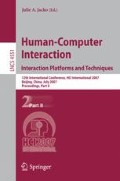Abstract
This paper presents the mobile version of Rich Book Player, a Digital Talking Book player for mobile devices. The mobile version is based on a desktop version with multimodal and adaptive features. The development of the mobile version tried to retain the look and feel of the desktop version and as much as possible of the features required for an advanced Digital Talking Book player. We describe how the intrinsic characteristics of mobile devices impacted the performance and interaction aspects of the application.
Access this chapter
Tax calculation will be finalised at checkout
Purchases are for personal use only
Preview
Unable to display preview. Download preview PDF.
References
Duarte, C., Carriço, L.: A conceptual framework for developing adaptive multimodal applications. In: Proceedings of the 11th International Conference on Intelligent User Interfaces, Sydney, Australia, pp. 132–139. ACM Press, New York (2006)
Jones, M., Marsden, G.: Mobile Interaction Design. John Wiley and Sons Ltd, Chichester (2005)
Moreno, R., Mayer, R.E.: A coherence effect in multimedia learning: The case for minimizing irrelevant sounds in the design of multimedia instructional messages. Journal of Educational Psychology 97, 117–125 (2000)
Gazzaniga, M.S., Ivry, R.B., Mangun, G.R.: Cognitive Neuroscience - the Biology of the Mind. W. W. Norton & Company (1998)
National Information Standards Organization: Specifications for the Digital Talking Book. NISO Press (2005)
National Information Standards Organization: Playback Device Guidelines (1999), available at http://www.loc.gov/nls/niso/features.htm
Gaver, W.W.: Auditory Icons: Using Sound in Computer Interfaces. Human-Computer Interaction. 2(2), pp. 167–177. Lawrence Erlbaum Associates, Inc, Mahwah (1986)
Duarte, C., Carriço, L., Guimarães, N.: Evaluating Usability Improvements by Combining Visual and Audio Modalities in the Interface. In: Proceedings of the 12th International Conference on Human-Computer Interaction, Beijing, P.R. China, Springer-Verlag, Berlin Heidelberg, New York (2007)
Author information
Authors and Affiliations
Editor information
Rights and permissions
Copyright information
© 2007 Springer-Verlag Berlin Heidelberg
About this paper
Cite this paper
Duarte, C., Carriço, L., Morgado, F. (2007). Playback of Rich Digital Books on Mobile Devices. In: Jacko, J.A. (eds) Human-Computer Interaction. Interaction Platforms and Techniques. HCI 2007. Lecture Notes in Computer Science, vol 4551. Springer, Berlin, Heidelberg. https://doi.org/10.1007/978-3-540-73107-8_30
Download citation
DOI: https://doi.org/10.1007/978-3-540-73107-8_30
Publisher Name: Springer, Berlin, Heidelberg
Print ISBN: 978-3-540-73106-1
Online ISBN: 978-3-540-73107-8
eBook Packages: Computer ScienceComputer Science (R0)

